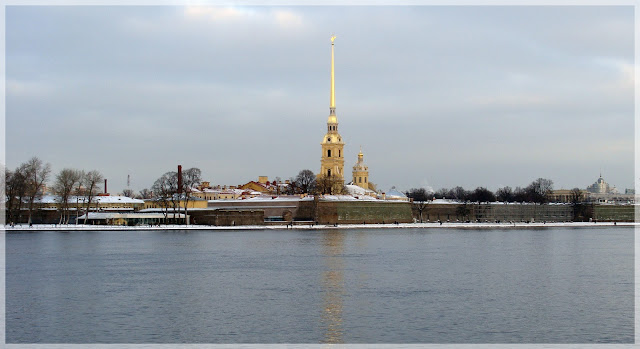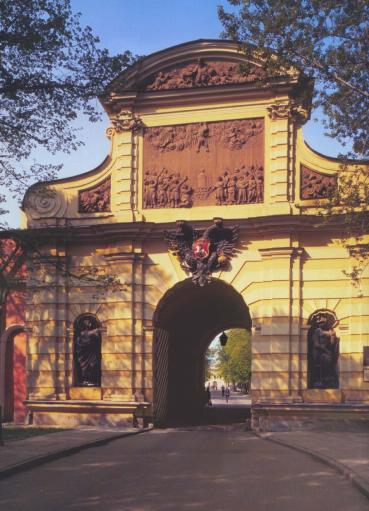About Saint Petersburg - Peter and Paul Fortress
 |
| Peter and Paul Fortress (view from Vasilievskiy island) |
Three hundred years ago, the first Russian Emperor Peter the Great conquered Sweden to gain Russian access to the northern seas.He tried to protect the land after gaining access to the Gulf of Finland via the Neva River. He installed himself on Hare Island, building the fortress known as Peter and Paul Fortress. The traditional date of laying the foundation of the city is considered to be May 27, 1703.
 |
| Panorama of Neva River upstream from Admiralty and Academy of Sciences. Engraving by E. Vinogradov Fig. MI Makhayev. 1753. fragment [1] |
In developing the plan of the fortress Peter himself participated, as he had studied the latest developments in fortification. Also participating was the military engineer Josef Lambert.
 |
| Peter and Paul Fortress plan [1] |
 |
| Plan of Saint-Petersburg 1753 year (fragment) [1] |
In the early years, the defensive structures were made earth and timber, but from 1706 to 1746 years they were replaced by stone. The original plan of the fortress was an irregular six-pointed star with each of the vertices of the bastion joined by curtain walls. Peter entrusted the construction of the bastions to his entourage, whose names (Menshikov, Zotov, Trubetskoy, Golovkin, Naryshkin, and Sovereign) are now those of the bastions themselves (his majesty the emperor oversaw Sovereign bastion personally). Added later were two ravelins, Alexis ravelin and Ioanovsky ravelin (which now hosts a museum space, several exhibition halls, a bookstore and information center).
 |
| Orderly gun at Naryshkin bastion of the fortress [1] |
 |
| Peter's gate. Drawing 18 century [1] |
To get to the island itself, one can cross Ionaovsky bridge. The entrance to the fortress is through Peter’s gates - a work by Domenico Trezzini, a Swiss Italian architect, invited to work in Russia. The gates are decorated with a bas-relief of the phrase "The overthrow of Simon Magus by the Apostle Peter." Attention is drawn Trezzini’s decorative treatment of architectural forms and sculptural construction of the gate. On the high attic a wooden rectangular relief was placed (sculptor C. Osner), an allegory glorifying acts of Peter, depicting him vaulting over the arched passage through the reinforced two-headed eagle - the symbol of the Russian Empire.
 |
| Peter's Gate [1] |
 |
| Peter and Paul Cathedral [1] |
The next masterpiece Trezzini created in the fortress was the Peter and Paul Cathedral, which became the burial place of Russian emperors. The cathedral bell tower forms a dynamic silhouette, topped by a high gilded spire and a weathervane in the form of an angel 122 meters above the fortress walls- making it one of one of the most dominant and expressive features of the city’s skyline.
 |
| The interior of cathedral [2] |
This cathedral marked the complete withdrawal from the traditions of Russian church architecture, becoming the epitome of the Russian "Peter" baroque style. The temple is more like places of worship in Western Europe, such as the Baltic hall-type Lutheran churches. The five cross-vaulted domes of the church do not resemble the form or plan of traditional four-pillared orthodox churches.
 |
| Headstone of Peter the Great [2] |
The general form of the cathedral is a rectangle stretching from west to east, with the interior span supported and divided by three pillars. (Later, the site was supplemented with an extension of Trezzini’s church, housing the tomb of the uncrowned royal family.)
The exterior appearance of the cathedral consists of large, rhythmically arranged pilasters. Large volutes buttress two levels of the bell tower, which rises on the western facade, giving the installation a harmonious silhouette. Their form varies according to level. The bell tower is covered with gold-plated cladding, and forms the base of the spire.
 |
| The angel on the spire of Peter and Paul Cathedral [2] |
 |
| Peter and Paul's Cathedral at night [3] |
The construction of the spire was a challenge at that time. Strong winds at structure height created difficulties for the design. The first spire was wooden, but in 1858 a Russian engineer Zhuravskiy replaced the wooden structure with one of iron forming a more rigid system. The design is reinforced by tension-adjustable cables on the inside of the spire itself. The figure of the six-meter angel holding a cross, crowning the spire, was originally anchored in place. However, due to strong winds, it often had to be repaired, and it was decided to transform the angel into a movable vane instead.
In 1720 the bell tower clock sounded the time with chimes, and in 2001 51 bells were added to the carillon.
 |
| Trubetskoy bastion prison [3] |
Peter and Paul Fortress never took part directly in hostilities. From the very beginning of its existence it was used as the main political prison of Russia, housed in Trubetskoy bastion. Trubetskoy bastion’s storerooms were used for housing state criminals from 1718.
 |
| Trubetskoy bastion prison [3] |
Interestingly, the walls inside the prison were specially constructed, soundproofed to prevent communication of prisoners. But the floors were not soundproofed, meaning that the prisoners could still use a special alphabet for tapping messages to each other.
[1] materials from the gallery of Saint-Petersbourg encyclopaedia http://www.encspb.ru/en/ [2] materials from the gallery of Museums of Russia http://www.museum.ru/ [3] material of official web-site of State Museum of the History of StPetersburg http://www.spbmuseum.ru
For future travellers:
http://www.spbmuseum.ru/en/
Hours: Museum open on Monday-Tuesday/Thursday – Sunday 11am – 6pm, Wednesday – no admissions. Ticket office closes half an hour before the museum, the entrance to the castle itself is open from 6am to 8pm.
View of St.Peter and Paul Cathedral (sperical panorama)
.jpg)

Comments
Post a Comment